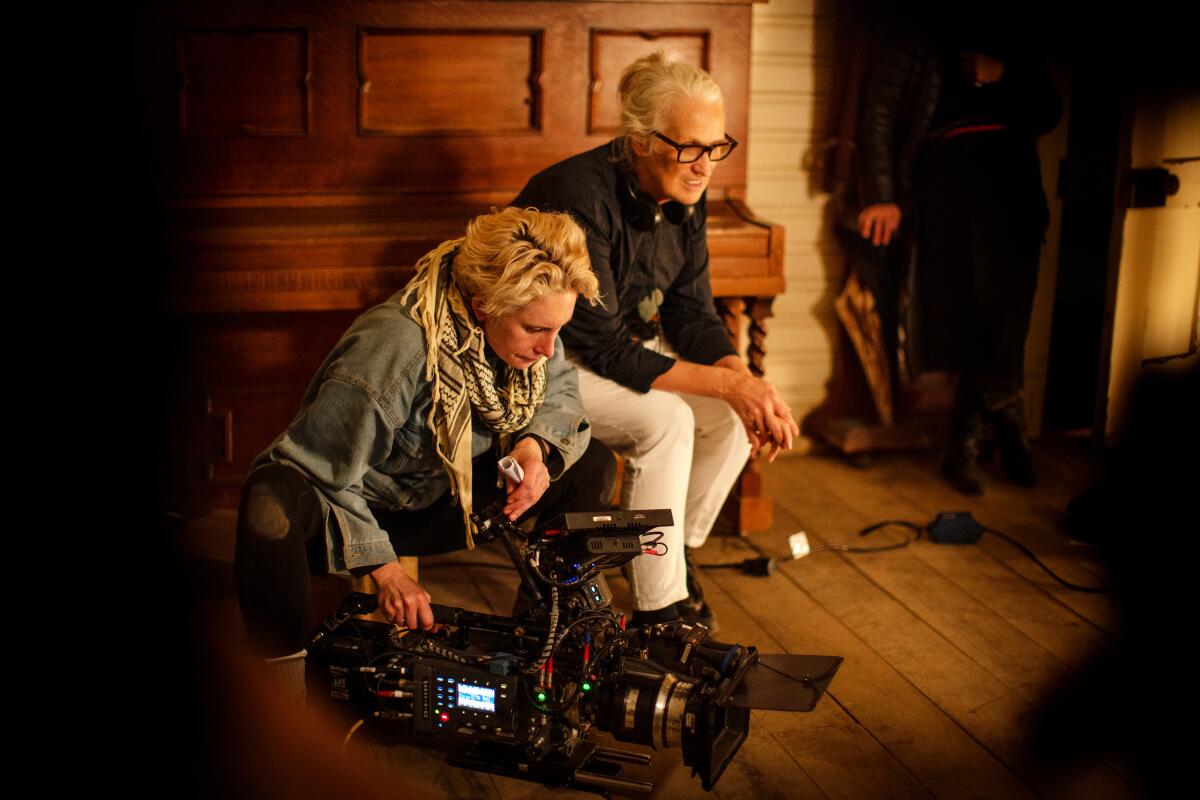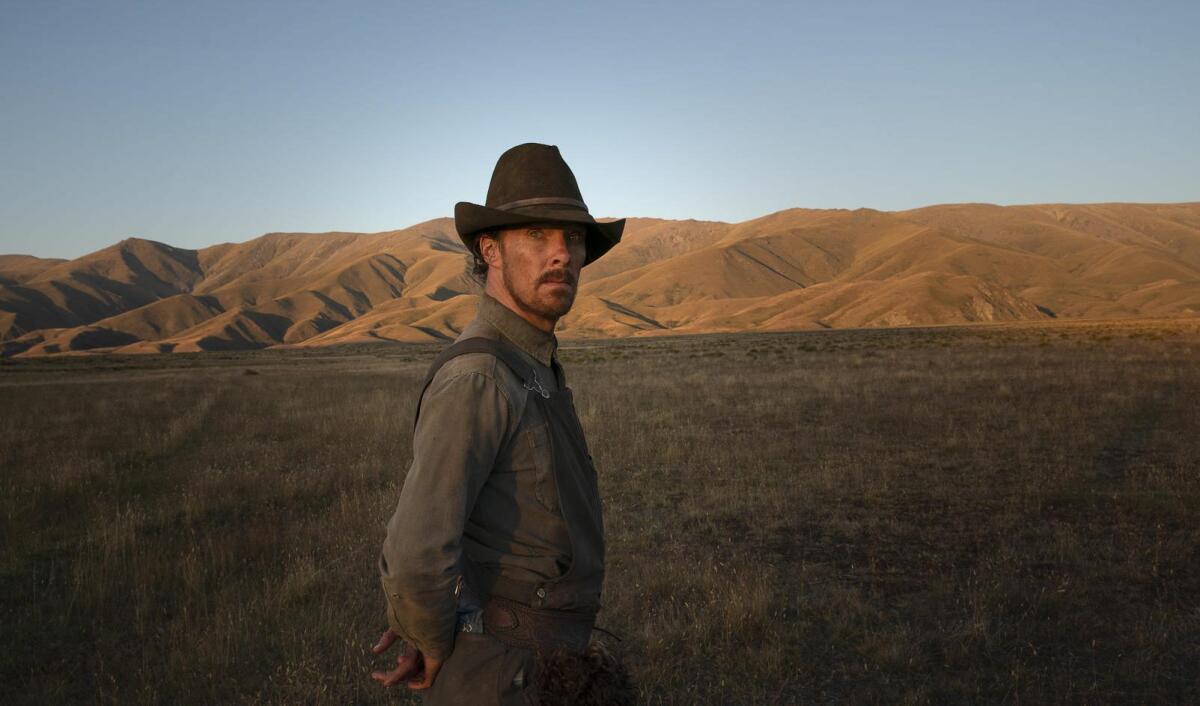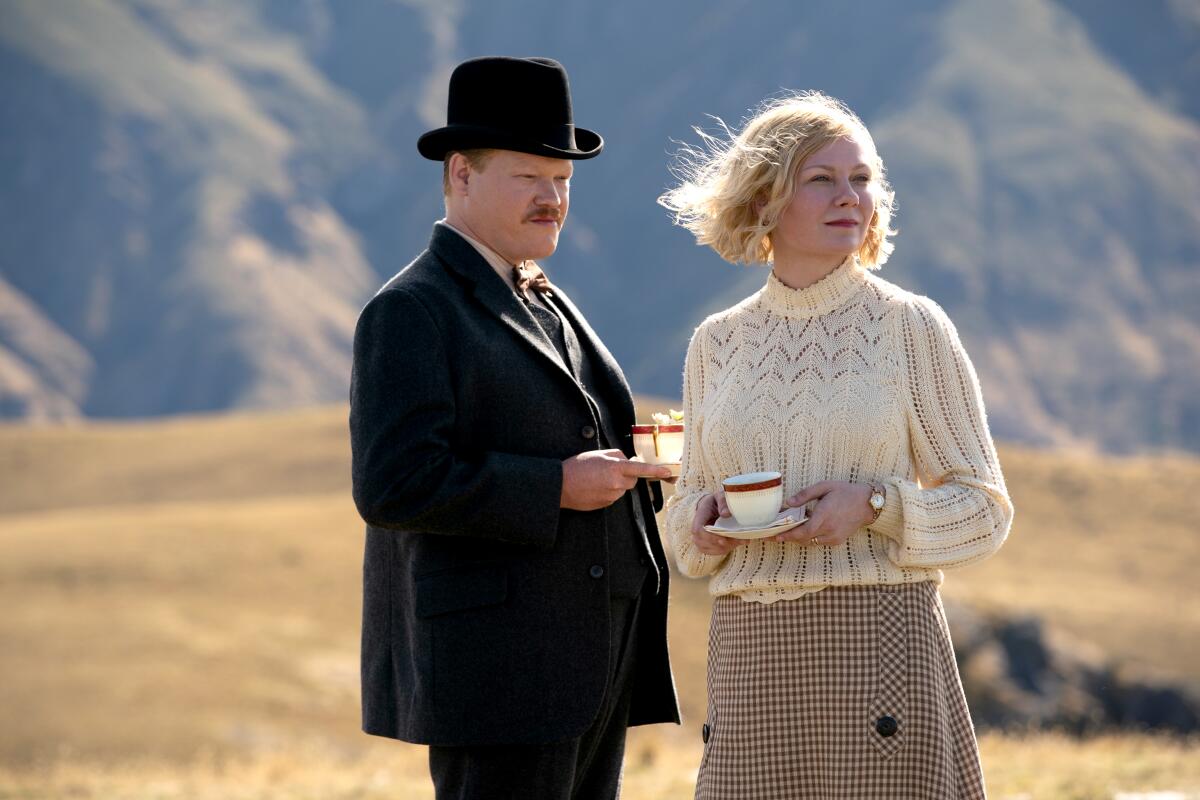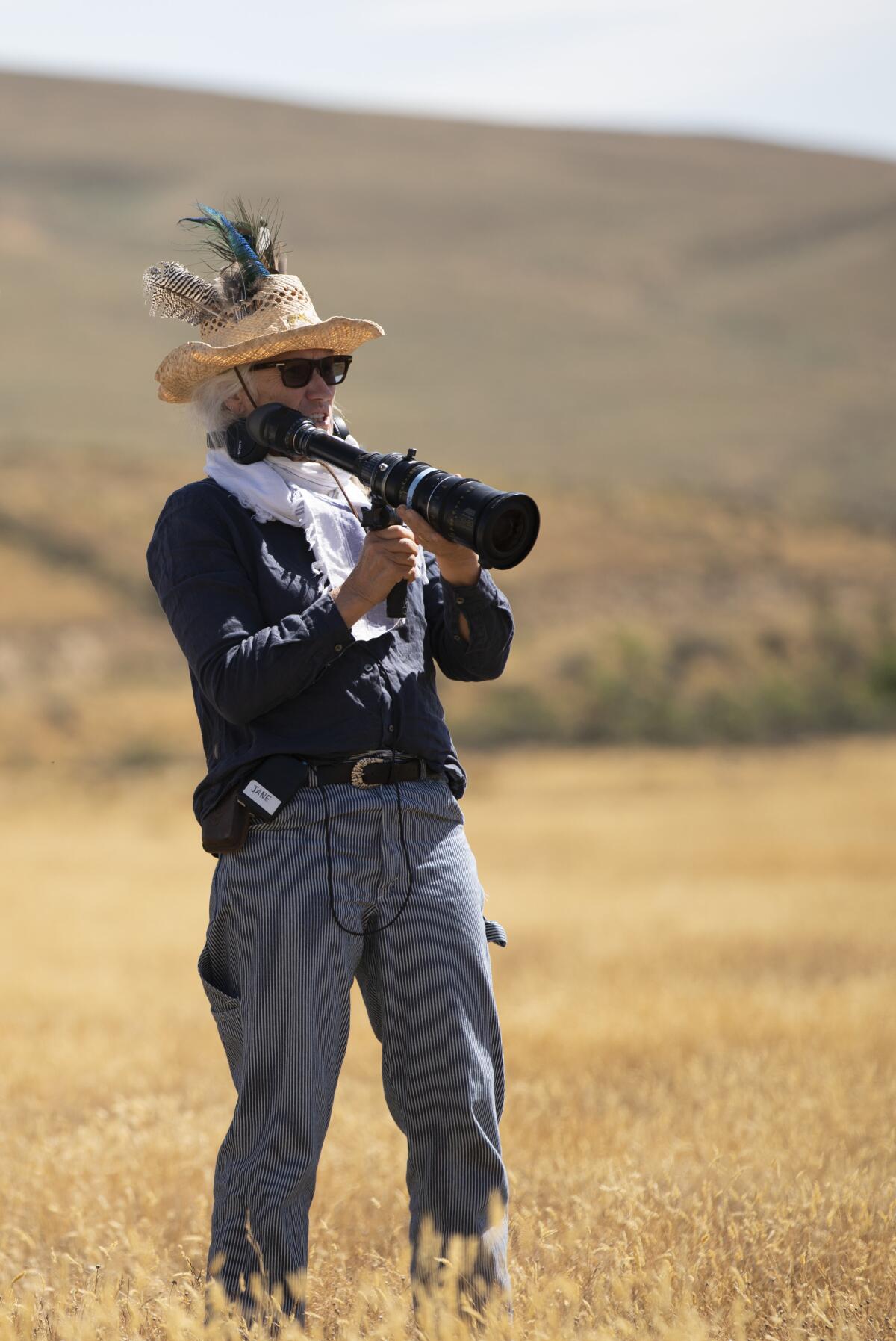‘The Power of the Dog’ topped the Oscar nominations. We asked Jane Campion how it feels

- Share via
On Tuesday “The Power of the Dog” received 12 Oscar nominations, the most of any film this year. Jane Campion was nominated for director, adapted screenplay and best picture. In the acting categories, Benedict Cumberbatch is up for lead actor, Kirsten Dunst for supporting actress and Jesse Plemons and Kodi Smit-McPhee for supporting actor.
Also nominated were Jonny Greenwood for score, Ari Wegner for cinematography, Peter Sciberras for editing, Grant Major for production design and Richard Flynn, Robert Mackenzie and Tara Webb for sound.
In the film, set in 1925 Montana, Cumberbatch plays Phil Burbank, a Montana rancher who torments Rose (Dunst), the new wife of his brother, George (Plemons). After being particularly cruel to her son, Peter (Smit-McPhee), Phil seems to take the youth under his wing, showing him the ways of the ranch.
In Sydney, Australia, Campion was asleep when the nominations were announced but was reached by phone later in the day.
What does it mean to you to see the film recognized so broadly with 12 nominations?
Well, it really did bring a tear to me. I felt really emotional and a sort of gratitude actually that the academy have so widely embraced so many of our team for this film. I think it’s a kind of complex film, so it meant a lot that they graced us with so many nominations. Absolutely a thrill for everybody.
Everyone’s talking about this statistic that you were the second woman ever nominated for best director with “The Piano” and now you are the first woman to be nominated for director for a second time.
Oh, I didn’t know that. Well, that statistic I hope is just going to be blown out of the park, that there’s just going to be so many more women. I’m really thrilled these last couple of years, just to see so many women do so well in the academy’s and different festivals’ prizes.
To be honest, the #MeToo movement really meant a lot to so many of us — that they have really helped to open the eyes of everyone to the systemic abuses that went on and the lack of equality. And I think that’s changed and I think that women are emboldened and it’s a great moment for all of us. For me, I feel emboldened too. I feel emboldened to do a project like this, which for a change has got quite a lot of men in it. And I don’t think I would’ve felt that without feeling how many other women were now making films and exploring the female space, and whatever space they wanted to really. So I give a lot of gratitude to those brave women who cracked it open and really risked a lot.

When you hear other female filmmakers, like Maggie Gyllenhaal, Sofia Coppola or Julia Ducournau, talk about you as an influence, what does that mean to you?
Well, I almost say I am surprised to hear it. And I’m happy if I could have been some encouragement to them in some way. I remember when I was at film school and there was only Gillian Armstrong and how much gratitude I had for her just being there in that space. And for me thinking, “Oh, a woman can do this too.” Just needs one person there to help you feel it’s possible. Of course there were others as well. Many, but not many enough.
And your cinematographer, Ari Wegner, is only the second woman nominated in that category.
My God, I’m so happy for her. It’s great. She’s punching her way through that glass ceiling. And then she’s just such a beautiful cinematographer and has such a respect for story and character. A brilliant, brilliant colleague to work with.
It must be very exciting to see all four of your main actors nominated.
I know, what about that? I’m so excited and happy that both Jesse and Kirsten, of course, both of whose work I adore and love — but we know that Benedict and Kodi Smit-McPhee have been getting lots of nominations and prizes, so I’m happy those two have as well.
It’s also so sweet to think of the two of them sharing this as a real-life couple.
So sweet. And now they have a real sort of sweet moment in real life together with the film, as well as at the end of the film when they have their first kiss.

I want to ask a little bit about how you like to work with actors. Do you have to find a different approach for every performer?
I think the main thing about working with actors is having enormous respect, for the courage that they have for the work that they do, and really partnering with them. I don’t even know what to say to an actor. They’ve got a big dramatic scene and, “Um, I don’t know, think of the worst thing that ever happened to you.” I don’t know what to say, but I do know how to be there with them and how to trust in their work and discuss it with them.
So I feel like it’s about as various and different with each of them as when you make best friends. The quality of friendship really is the way that I approach it. I’m not the boss at all. I’m their friend and we’re doing this together and, yes, I know something about taking charge of how we’re going to record them, the camera and the style of that, and try to make sure that they’re all in the same film together. But the actual excellence of their performance and depth of it and the openness of it is really their gift.
How did you come to the decision to have Benedict stay in character on-set? What were the conversations with him like to decide to do that for this character in particular?
Well, we knew it was a really difficult character to play and possibly for Benedict extremely difficult because he is a very friendly person, loves to connect with people. And he is not at all a dominator in that way. So he is more likely to want to please everybody. So it’s just really important, I think, for him to be told, you don’t need to do that anymore because you’re Phil. And Phil does not say please, he does not say thank you. He does not ask permission for anything. And you can just enjoy that now, for the whole of the shoot as Phil, and I’ll tell the crew and the cast that they’re not going to meet you until the end of the movie.
And I could actually see the relief in him. It was something that I was actually guessing a little bit that he wanted this too, he was sort of figuring out, “What am I going to do when I’m on set, and what about these people that just stay in character?” And I thought, “Well, that certain people ought to be you. Why don’t you do that? I think that’s a brilliant.”
And you mentioned how this is the first movie that you’ve done where you felt empowered to focus on male characters and I’ve heard you in some other interviews almost begrudgingly use the phrase “toxic masculinity.” For you, is that what the movie is about?
I think what I love that [author] Thomas Savage did as a true cowboy from Montana, he told an extremely subversive story about masculinity. So I wouldn’t say it’s about toxic masculinity. I think it’s a subversive telling of the story about a certain kind of masculinity and he just peels that onion to reveal what’s really underneath, which is yearning, loneliness, fear.
You see that quite early on in the story when Phil is alone and looking for George up in the bedroom, wondering where he is — he suddenly looks very small and just a moment ago he was bullying Peter about flowers. So for me it really is more a revelation or more an exploration of this character, Phil Burbank.

Do you find a big difference writing an original screenplay like “The Piano” and working on an adaptation like “The Power of the Dog?”
I think it is really different, but it’s also different for me. Writing “The Power of the Dog” was actually quite easy, because I had spent about eight years working on the “Top of the Lake” series. And I had to write 12 one-hour-long scripts along with Gerard Lee and it was a lot of work and it helped me. It made me a better writer so that when I came to do this project, I was really looking forward to doing a piece that is not like a long-form. It’s not like a novel, but actually taking what I wanted out of the novel and finding the short-story version of it. Trying to create something that had a tightness to it. And I think some of those elements were in the story originally.
Of course, things change when you start writing, I had to learn to speak in the voice of the different characters to make up new scenes as well. But the main glory is starting with a book like this, which is just so rich because it really was a life led by Thomas Savage. It just reeks with that feeling of authenticity, “Oh, this man really lived on that ranch.” And even though I think where Thomas Savage probably really existed was somewhere between Peter and Phil, because he was a great ranch man himself, he could break horses and in fact earned his money doing that for a while before he went off to university and became a writer. So I’m standing on the shoulders of a pretty extraordinary guy.
You mentioned your work on “Top of the Lake,” and this is your first feature film in about 11 years, since “Bright Star.” What was that like to come back to?
Well, it’s not very different. We have all the same crew and even used the same cameras as I did on “Top of the Lake.” I approached TV making like it was a novel and really enjoyed the visual world of “Top of the Lake” and the expansiveness of being able to move into digressive stories and things like that. But there’s a sort of way in which I was really yearning after all that to come back and do something concise, to work on telling a story within two hours. It felt like a sort of really beautiful discipline, whereas before it felt like a kind of a burden to get it all done in two hours.
There’s an on-set photo of you that’s now being used for posters and billboards where you are wearing this hat with feathers stuck in it. It’s a fantastic hat. Where did that come from?
I made it myself. It’s a $2 hat and I just started one day picking up some leaves, and it’s made of feathers and bits of trees. I just kept adding to it. And I was staying at an Airbnb place when we were making this film that had peacocks. So I’d find these feathers all over the place. And of course I had to add them.
On that hill [in the photo], that was the day we were shooting George and Rose dancing on the hill. And it was a really tense day because we had so much to shoot in a few hours for a particular light that we were looking for. And I was just standing up there waiting for the car to get in position further down to shoot the last shots of the day.
More to Read
Only good movies
Get the Indie Focus newsletter, Mark Olsen's weekly guide to the world of cinema.
You may occasionally receive promotional content from the Los Angeles Times.











